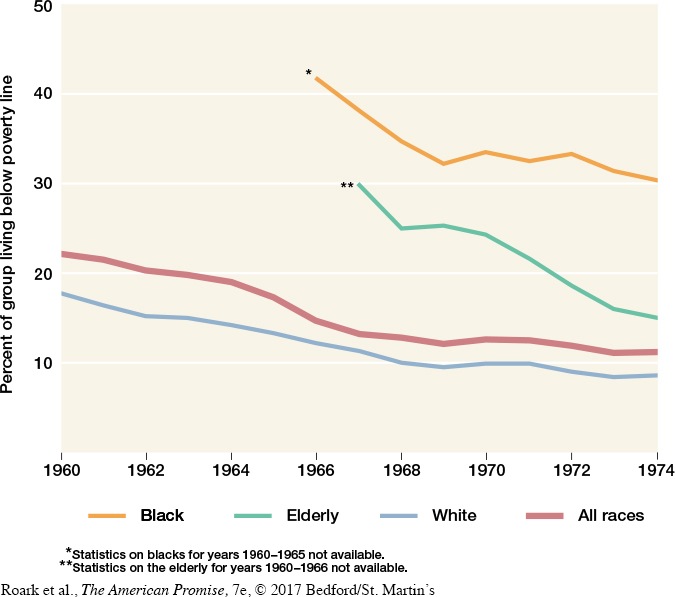Assessing the Great Society
The reduction in poverty in the 1960s was considerable. The number of poor Americans fell from more than 20 percent of the population in 1959 to around 13 percent in 1968. Those who in Johnson’s words “live on the outskirts of hope” saw new opportunities. To Rosemary Bray, what turned her family of longtime welfare recipients into taxpaying workers “was the promise of the civil rights movement and the war on poverty.” A Mexican American who learned to be a sheet metal worker through a jobs program reported, “[My children] will finish high school and maybe go to college. . . . I see my family and I know the chains are broken.”
Certain groups, especially the aged, fared better than others. Many male-

Reforms of the Great Society, 1964–1968
| 1964 | |
| Tax Reduction Act | Provides $10 billion in tax cuts in 1964 and 1965. |
| Civil Rights Act of 1964 | Bans discrimination in public accommodations, public education, and employment and extends protections to American Indians on reservations. |
| Economic Opportunity Act | Creates programs for the disadvantaged, including Head Start, VISTA, the Job Corps, and CAP. |
| 1965 | |
| Elementary and Secondary Education Act | Provides $1.3 billion in aid to elementary and secondary schools. |
| Medical Care Act | Provides health insurance (Medicare) for all citizens age sixty- |
| Voting Rights Act | Bans literacy tests and other voting restrictions and authorizes the federal government to act directly to enable African Americans to register and vote. |
| Executive Order 11246 | Bans discrimination on the basis of race, religion, and national origin by employers awarded government contracts and requires them to “take affirmative action to ensure equal opportunity.” |
| Department of Housing and Urban Development | Provides programs to improve housing and neighborhoods in urban areas. |
| National Arts and Humanities Act | Creates National Endowment for the Arts (NEA) and Humanities (NEH) to support the work of artists, musicians, writers, and scholars. |
| Water Quality Act | Requires states to set and enforce water quality standards. |
| Immigration and Nationality Act | Abolishes fifty- |
| Air Quality Act | Imposes air pollution standards for motor vehicles. |
| Higher Education Act | Expands federal assistance to colleges and universities. |
| 1966 | |
| National Traffic and Motor Vehicle Safety Act | Establishes federal safety standards. |
| Model Cities Act | Authorizes more than $1 billion to ameliorate the nation’s slums. |
| 1967 | |
| Executive Order 11375 | Extends an earlier executive order banning discrimination and requiring affirmative action by federal contractors to cover women. |
| 1968 | |
| Civil Rights Act of 1968 | Bans discrimination in housing and jury service. |
| National Housing Act | Subsidizes the private construction of 1.7 million units of low- |
Conservative critics charged that Great Society programs discouraged initiative by giving the poor “handouts.” Liberal critics claimed that focusing on training and education wrongly blamed the poor themselves rather than an economic system that could not provide enough adequately paying jobs. In contrast to the New Deal, the Great Society avoided structural reform of the economy and spurned public works projects as a means of providing jobs for the disadvantaged.
Some critics insisted that ending poverty required raising taxes in order to create jobs, overhaul welfare systems, and rebuild slums. Great Society programs did invest more heavily in the public sector, but the Great Society was funded from economic growth rather than from new taxes on the rich or middle class. There was no significant redistribution of income, despite large increases in subsidies for food, housing, and medical care. Economic prosperity allowed spending for the poor to rise and improved the lives of millions, but that spending never approached the amounts necessary to claim victory in the War on Poverty.